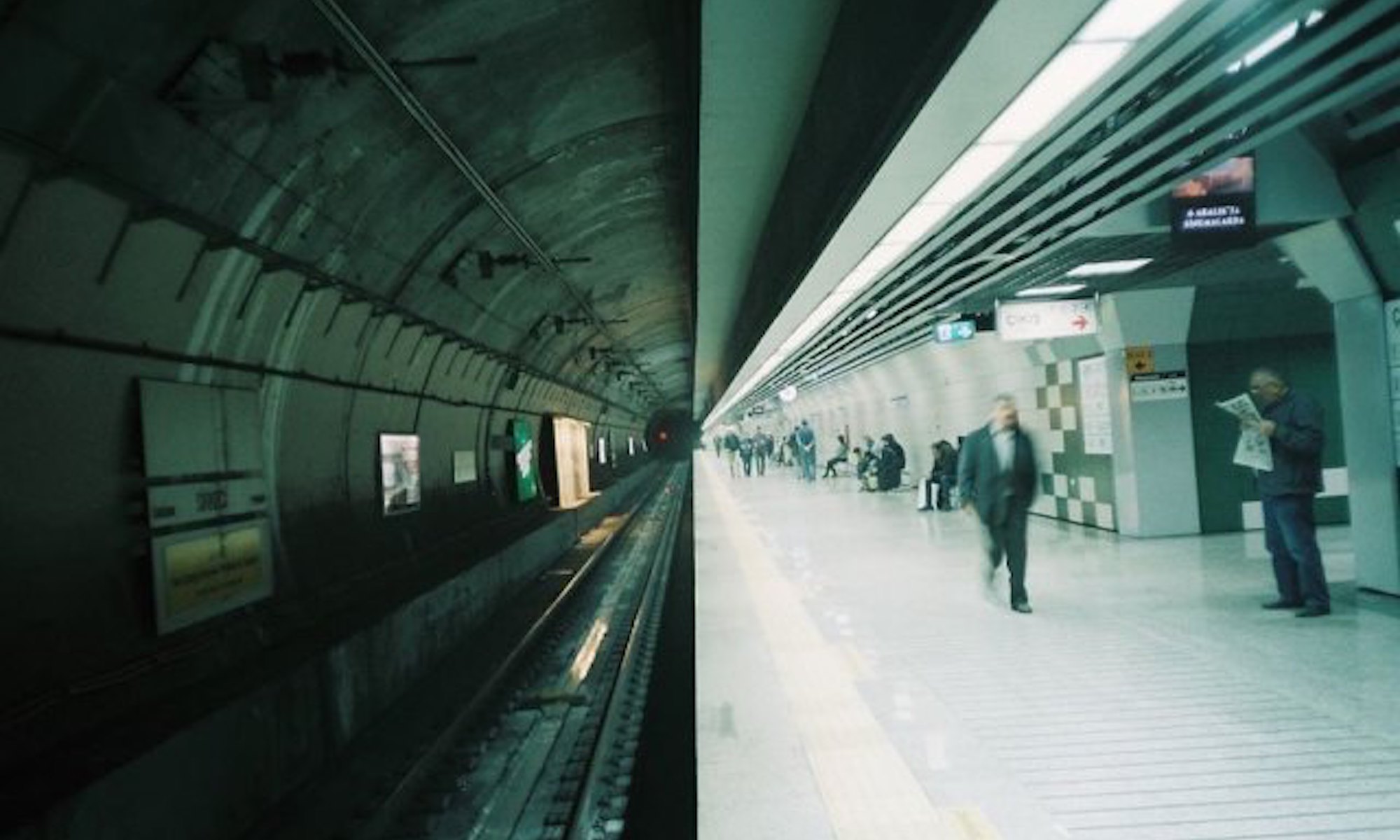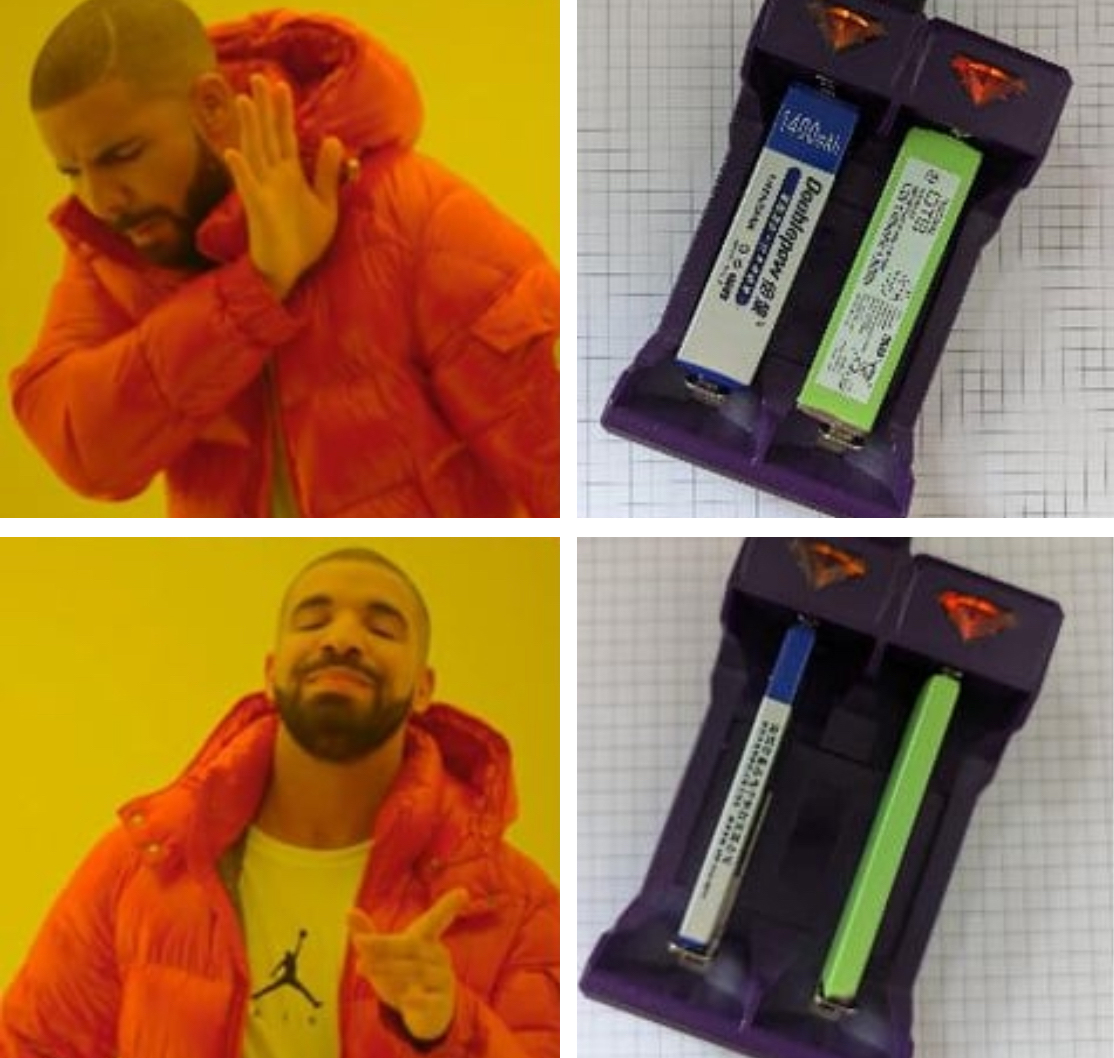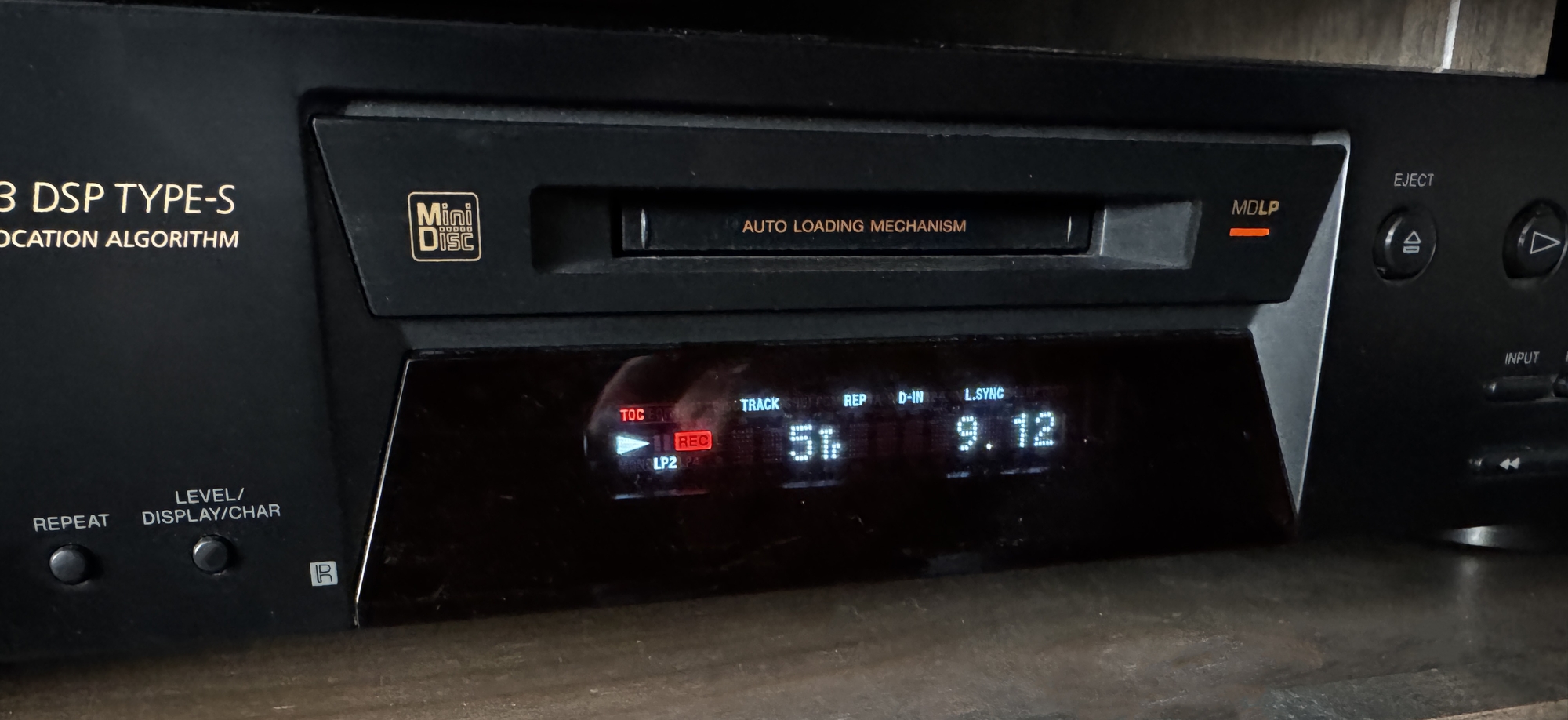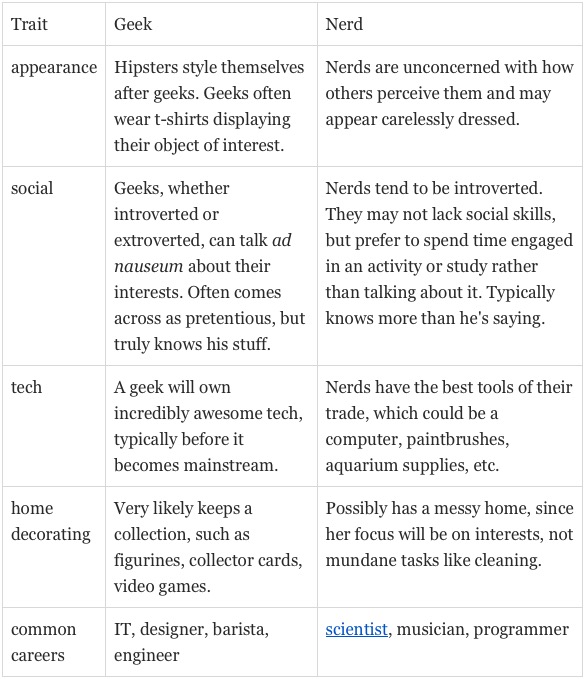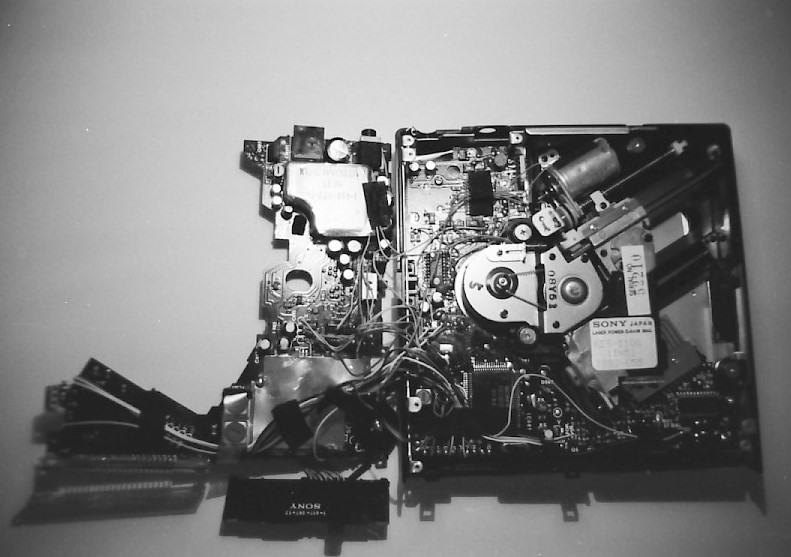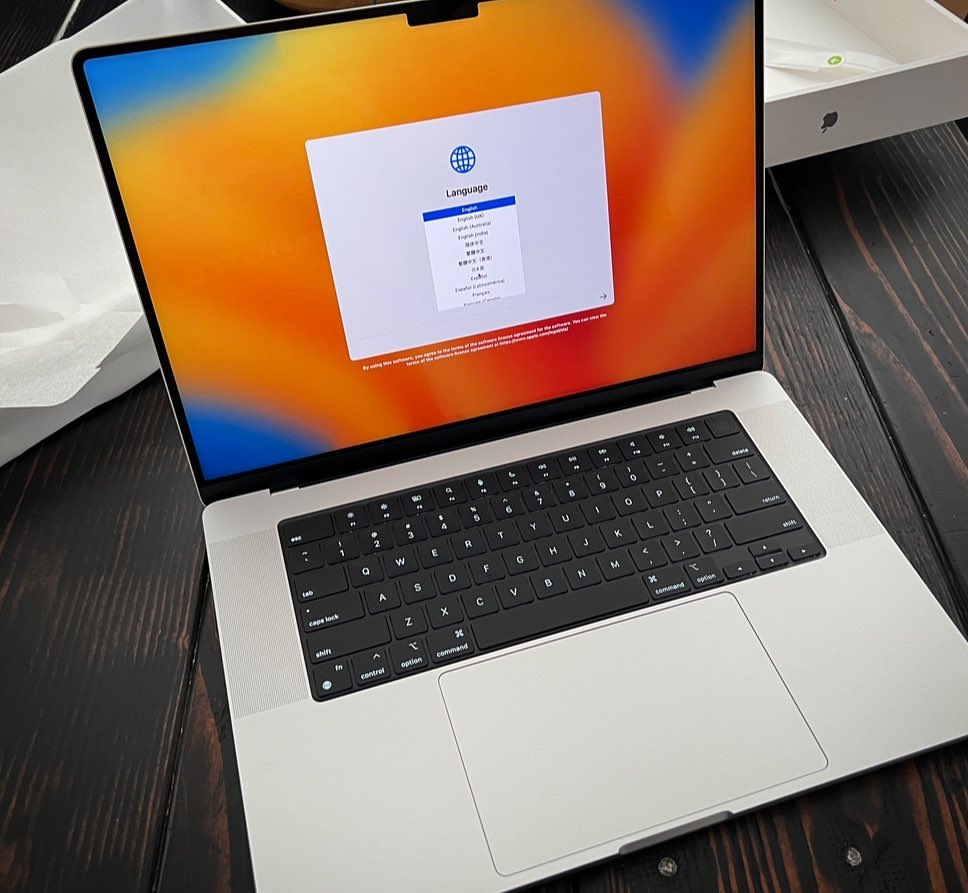If you know, you know. If you don't, that's okay too.
Not Untrue!
Off to a Rough Start
I recorded my first minidisc in over a decade last night.
And after I finished, ejected the disc so it could finish writing the table of contents, and when I reinserted the disc to listen, the machine took a crap. C13 Read Error. Ugh. And it wasn't just that disc—it was even brand new, unused ones. And of course the seller I bought it from said it was fully functional and doesn't accept returns.
Being a nerd that's still relatively good at fixing shit, I did a hasty search online and ended up getting very depressed. Firstly, because there wasn't a whole lot of info out there and a lot of it was, "Take it to a Sony Service Center." Yeah, like that's an option any more…
I did all the suggested troubleshooting: cleaning the laser's lens, blowing out the mechanism with compressed air, reseating the ribbon cables that run between the mechanism and the main circuit board, etc. But none of it worked.
Anyhow, after mulling it over while wide awake at 4 am this morning, I thought about one other possible culprit: dried lubricant on the sled rail.
After getting ready this morning, did a search on YouTube and found one video that described the error and what needed to be done. It was basically everything I'd already done, but I felt that if the guy in the video could resuscitate a machine that was in much worse condition than mine, I certainly could get this one working.
I pulled the top off again and did everything I'd done last night and in addition, ran a Q-tip drenched in isopropyl alcohol along the rail and under the gears that drive the mechanism. I cautiously inserted the disc from last night and viola! it worked!
So fingers are crossed. As I type this I'm adding a few more tracks to the disc from last night and so far everything is working as it should. The true test will be when I'm finished and it has to write to the TOC (Table of Contents) before ejecting…
UPDATE: It worked!
UPDATE #2: It's hosed. After recording two discs, the error returned. After popping the cover was obvious the disc was refusing to spin up, triggering the C13 error. I spoke to the seller this afternoon and she's agreed to refund what I paid for it upon return of the unit. On the positive side, the MZ-S1 arrived today and it works like a champ.
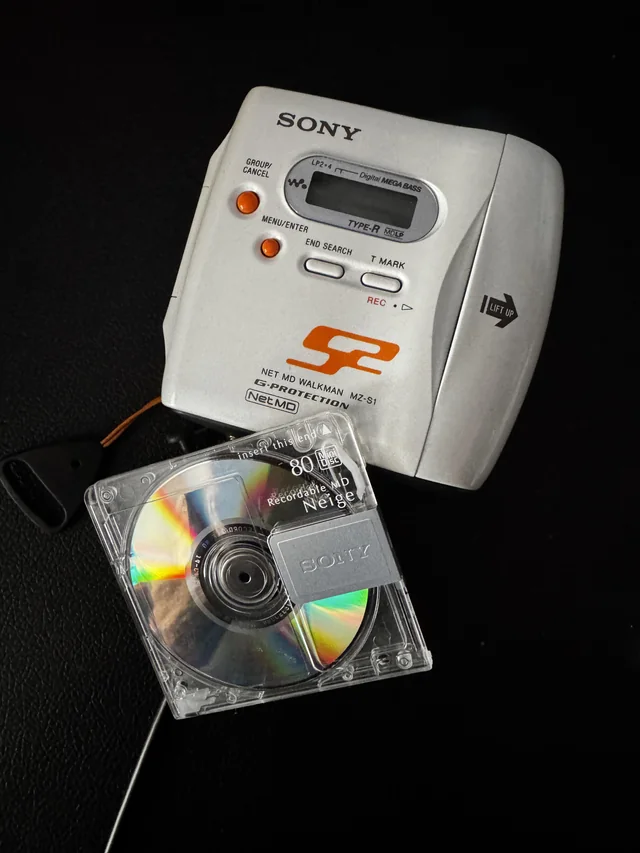
IYKYK 🤣 🤣 🤣
After That Last Post…
What a Difference 38 Years Makes



Isn't technology grand?
Of the lot, the D-171 is my favorite just because I've had it for so long and its reliability after all these years, but I have an real affection for the D-10. While not being the original Discman model I owned, it was the player that—somehow, considering how much it skips if you sneeze in its general direction—got me through years of commutes in San Francisco; an undeniable nostalgia factor. The sound quality itself is also so much better than the other two there's just no comparison and for that reason alone it's the one I listen to the most. I just wish it played all disks as reliably as the other two. I'm not even talking about CDRs (surprisingly all three will play them even though CDRs weren't even a thing when the D-10 was in production). For example, the D-10 absolutely refuses to play all the way through Revolver, the last track on disk 1 of Madonna's Celebration (an absolutely pristine commercial disk, btw) and no amount of cajoling can convince it to do otherwise. (The disk plays flawlessly everywhere else.)
But admittedly I do like the quirky design of the D-EJ100. You can't see the disk spinning like with the others, but that neon lime green center circle display is an absolute chef's kiss in my opinion. Of the three, it also has the best skip protection and fits inside my headphone case like it was made for it, making it the perfect traveling companion in the already overstuffed messenger bag haul back and forth to the office. The sound quality isn't as good as the D-10, but it's good enough to get though those three days I have to be physically present at corporate HQ.
By the Late 90s…
…and early 00's, Sony had their Discman shit down to an art. It's really too bad the whole product line died only a couple years later with the advent of the iPod because it really is amazing technology.

Yeah, the Discman cases went all plastic, but everything was now consolidated onto a single circuit board, a definite improvement in terms of serviceability. Remove four screws from the bottom and the top/tray pops right off…unlike my beloved D-10 which has two double-sided circuit boards linked by a ribbon cable, multiple wire connects, and is much more complicated:
Or this, my original D-7 from 1986 with a belt-drive spindle motor. And look at that laser transport!
Still a feat of miniaturization and engineering considering that full-size CD decks only came on the scene a few years earlier.
Remember…obsessed.
This Is Why I'm Buying CDs Again
I'm Such A Nerd
Where's my pocket protector?!
So as I mentioned in passing a month ago (has it only been a month?) I got this blinkie-light thingie (a power/line level LED meter) for my stereo. For some reason this particular unit is rarer than proverbial hens' teeth (could be the age, or the limited production run, or both), so when it showed up on eBay I immediately snagged it.
I bought one new back in 1979 (minus the oak end panels) when it first came out, but after a decade or so of use I grew weary of it, and somehow it ended up in the trunk (or boot for those in the UK) of my then-boyfriend's car, thinking it would get dropped off at Goodwill at some point. Unfortunately, this was while I was living in SF and because parking on the street is the norm, when the inevitable car break-in happened, it was gone, along with whatever else happened to have been in there.
Anyway, after all these years I thought I knew everything it was capable of doing. What I didn't know—and just discovered today—was that it also had a peak-hold function that displays the highest signal level attained for a small period of time. I knew the silver button on the left side of the unit switched between line-level and RMS (power) display, but I started wondering why in addition to a switch it was also a potentiometer. So I turned it, and all of a sudden the peak levels were holding (the single LEDs that are separate from the main readout in the photo above), similar to how the meters work in my Technics amp. How long they remain on is dependent on how far you turn the knob. Who knew? There is no mention of this whatsoever in the admittedly-sparse instruction booklet—and frankly I think my original unit simply had a standard pushbutton, so it may explain why I missed this all these years. (This unit may be a later production run than what I had originally.) Sadly it only seems to work on the line-level inputs, not the power level side of things, but it's still pretty damn interesting that it can do this.
I'm such a nerd.
505 Internal Server Error
Or maybe…
508 Loop Detected
403 Forbidden
404 Not Found
405 Method Not Allowed
406 Not Acceptable
407 Proxy Authentication Required
408 Request Timeout
409 Conflict
413 Payload Too Large
417 Expectation Failed
422 Unprocessable Content
425 Failed Dependency
425 Too Early
426 Upgrade Required
Oops! I Did It Again
If you remember, I was in a bit of a quandary when I replaced my MacBook Pro in 2021. 16 or 14-inch M1? That was the question. 16 ordered. Immediately cancelled because I decided it was too big and heavy. 14 ordered. Ten minutes later, 14 canceled and 16 reordered. Half an hour later 16 canceled and 14 reordered.
The 14 has been fantastic these past two years (where has the time gone?) and I really had no intention of getting rid of it until it reached the point where it would no longer accept OS upgrades, but after gazing over at Ben's 16-inch longingly because of the added screen real estate, I went online and checked prices. Using Ben's education discount (there are many advantages to being married to an educator) and a very generous trade in allowance being offered by Apple on my 14, it was kind of a no-brainer.
Yeah, I was still a bit concerned about the overall size and weight—not to mention the rather…lackluster…reviews the M2 machines had gotten, but I figured I'd give it a try (I had two weeks to return it, after all) and if it proved too unwieldy or performance was unsatisfactory, I'd send it back and return to my trusty 14.
Well, after only 48 hours, I am quite enamored of this machine and will be holding on to it.
Yeah, I had to order a new Timbuk2 bag to account for it's extra…girth…but that's a minor point.
They're Not Wrong

Satisfying
Back Into The Fray
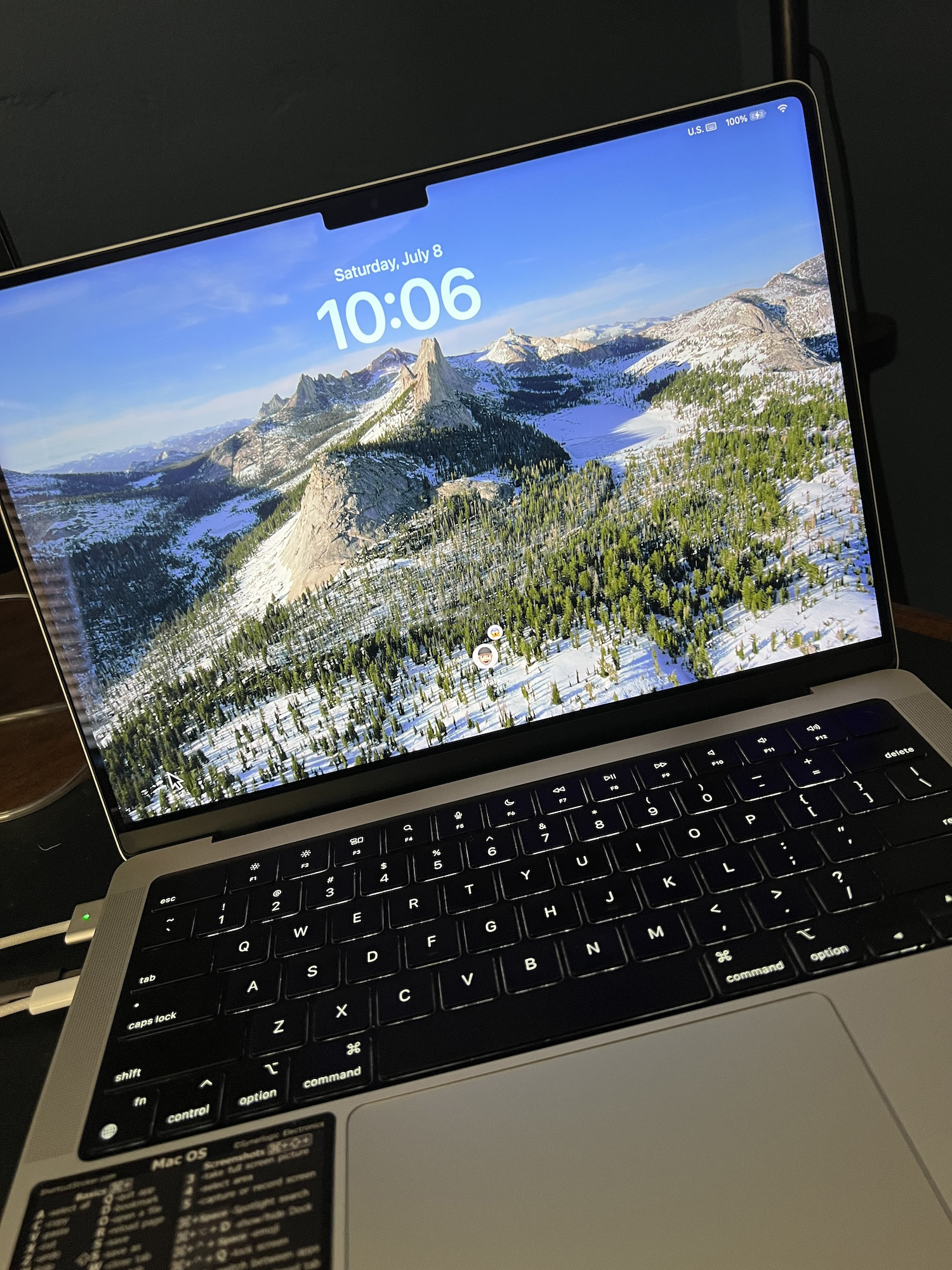
I had some issues with the first Developer Beta that I eventually overcame. Other issues popped up to the point that I gave up and wiped the drive, swearing the whole thing off until we got further into the development cycle.
Being a bear for punishment, when Beta 2 was released I jumped back on. As is often the case, things that were working perfectly fine in one beta get broken on a subsequent one. This was the case with Beta 2.
I have Sonoma installed in a separate container on the main hard drive. Since the drive isn't big enough to completely clone everything, when I migrated migrated my profile, I left Documents, Pictures, and Music in the original locations, being diligent when using Sonoma to just point everything I changed or added back to those original folders. It's worked like this forever with no problems. Forever until Beta 2. For some reason the original Ventura installation wasn't recognizing my account from Sonoma, even though it was identical (logged into the same Apple account, same name, same password, etc.). When I checked permissions on the Ventura folders it saw my "Mark" account as something new and was stuck in a loop "getting permissions." After several days I have up trying to fix it, wiped everything and happily went back to Ventura.
Well, Beta 3 (usually the point in the past where I've jumped in because it's the point where things start to stabilize) came out last week, and—being a glutton for pushment—I installed it again. I don't know if I did something different, or if the issue had simply been fixed, but my permissions errors were gone. I could access everything on the Ventura partition without issue, and several other glitches were seemingly rectified in this release as well.
Is it ready for release? Not by a long shot, but it's definitely further along. It's not an earth-shattering update to Ventura, but there are lots of nice little refinements that I find useful and I think most Mac users will appreciate.
Since We're Reminiscing About Old Technology…
…let me wax poetic for a bit about my very first hi-fi system.
The Sony TA-5650 was my first hi-fi amplifier, purchased with some high school graduation money. I'd owned "stereos" throughout my school years, but this was my first real piece of high end gear. Utilizing the then-new V-FET (vertical field effect transistor) technology, it produced a sound that could only be described as delicious. Unfortunately, it had the rather annoying penchant for self-destruction, that I've written about previously.
I purchased these Infinity loudspeakers at the same time I got the Sony amp. A good friend in high school had gotten a pair a year earlier and we both liked them, even though they were at the low-end of the Infinity lineup. I remember several things about the purchase. Firstly, the sales people were like, "You're putting these with that Sony?!" Secondly, the salesman had a blond mustache I wanted to take a ride on, and lastly, I'd had a pair on layaway for a month. When I went to pick them up, they told me I'd have to take the display models because they didn't have any stock. I wasn't having any of that bullshit. "They're on layaway. You will find a new pair."
Miraculously, a brand new in-box pair appeared in the back room. Sometimes causing a scene is necessary.
I'd been lusting after my friend's SL-1300 since it first appeared in his bedroom in 1973. It was a beautiful piece of tech, but sadly was no longer being manufactured when I actually had the funds to buy my own. It had been replaced with an upgraded version, the SL-1600 (which was, actually, so much better in so many respects). I kept this for several years, until I gave it to my sister after upgrading to this:
Another beautiful, cutting-edge piece of tech that had issues. This is still probably my favorite Technics series ever produced, despite it's long-standing issues with the tonearm lift mechanism. I still have the one I purchased off eBay in the early 2000s whose arm was permanently repaired, although I'm not currently using it, having acquired a SL-1200mk2 about two years ago.
I got this beauty out of frustration after the 1300mk2 had been sitting in the shop for over three months. Again, I had wanted to buy perhaps the all-manual version of the 1300mk2 (the 1500mk2) and then sell it when I got the 1300mk2 out of repair, but like the 1300/1600 debacle, the line had been discontinued. So this was a decent, relatively inexpensive alternative. This is the one table that stayed with me until I foolishly sold all my vinyl after moving to San Francisco in the mid 80s.
This was my first cassette deck, finally acquired in 1984. It was good, not great, but certainly served its purpose. Even with the advent of CDs, minidisc, MP3s and streaming, I do still kind of miss cassettes. They were wondrous things in their day. At one point I think I had a hundred or so mix tapes…
I think I still have maybe a handful squirreled away in a box somewhere, but nothing to play them on.
Of course, there is a lot more to the story of my hifi journey over the course of my life, but this was where it all started.
Forgotten Audio Formats: Elcaset
WARNING: Geek stuff ahead!
When I first saw an Elcaset deck back in the mid 70s (shortly after high school graduation, as I recall) it sent my little wannabe audiophile heart aflutter. I'd just started building my first hi-fi system and design-wise the Sony decks were a perfect match to my newly-acquired TA-5650 V-FET amplifier. I'd yet to even acquire my own cassette deck at this time—so I viewed this as a viable, if pie-in-the-sky alternative. At $700-800 retail, they were hopelessly out of reach, and by the time I started making the kind of money where I could afford one, the entire format vanished from the scene.
From ARS Technica:
Paying tribute to the lamented, giant-size Japanese cassette Hi-Fi fans love to love.
Back before all-digital music, back before the Digital Compact Cassette, back before even the Digital Audio Tape existed, there was a strange audio device that briefly captured the imagination of Hi-Fi freaks across the world. The Elcaset, as it was called, was an enlarged cassette that started in Japan, wove its hidden, spinning spools around the world, and then finished, appropriately enough, in Finland.
The humble compact cassette was already more than a decade old in 1976, and its pros and cons had by then become fairly clear to most punters. It wasn't a huge reel-to-reel deck as was used by pro studios and was thus portable by the standards of the day—even though Sony's cassette Walkman was still a few years away.
The compact cassette's sound was generally acceptable for a generation raised on crackly mono Dansette record players. But the small tape size—two sets of stereo tracks squeezed onto a strip of tape just 3.81mm wide—and the slow playback speed of 4.76cm (1⅞ inches) per second rendered the device incapable of really capturing and playing anything near the full sonic range that music ultimately requires. What's more, there was often plenty of hiss that couldn't easily be masked.
So 40 years ago, a trio of rising Japanese electronics giants decided to inject some quality into the game, something that they hoped would hit the Hi-Fi market as well as aspiring consumers and indie studios. Thus Panasonic, Sony, and Teac came up with the Elcaset, a larger small format. It was virtually twice the size of the old cassette—more like a paperback book in size, at a hefty 15cm wide, 10cm tall, and 2cm deep.
It contained quarter-inch tape running at double the speed of regular cassettes, which naturally gave the format greater frequency response and a wider dynamic range, as well as much less hiss. It also had six tracks, despite still playing back in stereo—the third track on each side was for a cue function that was designed as an additional facility that studios could use but never fully implemented.
The other big difference was that the Elcaset's tape was gently pulled away from the body shell when it was played so that even the most scuffed—or crudely-made—frame wouldn't affect the audio signal.
To put it in technical terms, the cassette had a high-frequency bandwidth that hardly got over 16,000Hz, whereas Elcaset exceeded 25,000Hz and had a fine mid-band (the region in which most vocals and guitars live). It made a better noise, basically.
The best Elcaset decks had three motors, three heads for playback, recording, and erasure, closed-loop dual capstan, VU meters, and remote control. All in all, they sounded pretty damn good.
Sony, Teac, and Panasonic had their own top-of-the-range versions as well as more reasonably priced decks, and there was even a hand-bag sized "portable" version, the EL-D8, which looked like, and essentially was, a piece of mobile pro-audio kit. With a "big four" PR launch—input from Panasonic, Sony, Teac, and then Hitachi—for their "revolutionary Elcaset system," the format should have become a big seller. There were some good reviews, and certain pundits still claim today that Elcaset's overall performance was virtually as good as leading, mid-range reel-to-reels at the time, such as the Revox A77.
So with the cassette already battling the newish 8-track cartridge, the manufacturers believed Elcaset would apply the killer blow to the older format, leaving it to struggle with the 8-track for market supremacy.
Reel talk
Unfortunately, Elcaset's arrival in 1976 coincided with the year that sales of several other innovations took off. One of these was the chromium oxide (CrO2) cassette, which, while not quite matching the finesse of the Elcaset, did greatly improve cassette sound and could crucially be used in any existing cassette player. The CrO2 cassette cost 40 percent more than a normal tape, but for the audiophile or the discerning pop fan, there was now a premium recording-cassette that didn't require a whole new deck. The leading tape manufacturer, Sansui, eventually started to make Elcaset tapes after Sony belatedly brought out a chrome tape of its own for the new decks. But this was already too late.
For the compact cassette player, there was also Dolby B, which looked and sound fairly fresh on the scene. Dolby B (which funnily enough followed after Dolby A) took out the hiss, reducing noise without overly affecting the sound, again adding value to the existing, cheaper format.
Another innovation, aimed purely at the Hi-Fi market, was a superb range of cassette players from Japanese firm Nakamichi, which had been making them since the autumn of 1973. These slowly gained a great reputation as they squeezed every last drop of sound from a compact tape and, when used with a chrome cassette, almost gave vinyl a run for its money. Decent examples of the legendary Nakamichi Dragon player still command three- and four-figure sums today.
And speaking of money, one minus point amid a splash of mainly good reviews was the Elcaset's exorbitant initial price—coming in at more than £1,200 ($1,582) in today's money. So when indie sound studios realised that the sound was going to be, in some cases, a little worse than a cheaper used reel-to-reel deck, that market started to shy away. The convenience of Elcaset would have saved a little studio time, but not enough to warrant the outlay.
On top of this, reel-to-reel was comparatively easy to splice—to edit with, literally, razor blades. Elcaset on the other hand could only be dubbed, and recording drop-ins could never be as accurate even if the cue system were ever completed.
As for domestic sales, Hi-Fi was costlier back then anyway, but such a price was a big leap for all but the most dedicated audiophile. No way was the average Joe going to spend such an amount on what many just saw as a glorified cassette. The last straw, domestically speaking, was the failure of Sony and the others to provide prerecorded tapes. Many people, even Hi-Fi freaks, didn't always want to have to record their own stuff.
Some just wanted to buy Top 40 albums off the shelf of their nearest music store—but they couldn't with Elcaset. This would prove to be an error that Sony barely noticed and repeated with the Betamax video format—their last such content mistake; subsequently they bought up CBS Records as well as shares in various film companies.
What do I get?
Elcaset tech was undoubtedly ahead of its time, though, and the extra-shell tape handling that it featured would go on to dominate the video market for the following 25 years with VHS and S-VHS. The people behind the "biggest, bestest" cassette just hadn't considered the public's price limits, their love of prerecorded material, or even the possibility that existing rival formats could still develop their own innovations.
In 1980 the Elcaset itself officially died, the last few thousand unsold players auctioned off at a fraction of their worth to the highest bidder. Incredibly, there were virtually no serious bids from the US, Japan, or even Western Europe, and the highest bid actually came from a Scandinavian distributor. So the last Elcaset players ended up in bargain basements in Finland, blasting out at the snowy forests while the rest of the music world began to forget about their beloved cassette's short-lived big brother.
The story doesn't quite end there, though, as the undoubted quality of Elcaset has ensured it a small place in history—those who used it with dbx type 1 noise reducer swear its quality eclipsed all but the best of the professional decks. There's also no denying that these machines were built for the ages; there's many a tale of Elcaset players being found in attics this century after 25 or 35 years in storage and still playing perfectly.
Analogue audio fans still swap "elcassy" tips on sites such as tapeheads.net, and if you ever need to lube your belt and two spools—and you probably will with the older Sony tapes—this is definitely the place to find out how. There is now a niche but steady market in secondhand Elcaset players and unused Elcaset tapes, not just on eBay, but in Finland, the UK, US, and Poland.
Just as the humble cassette is now seeing a resurgence among trendy bands and boutiques—there have even been Cassette Store Days since 2013—so we can expect a fair few Hi-Fi freaks and hipsters to increasingly cherish the dwindling audio El Dorado that is, or rather was, the Elcaset.
Quirky
I like quirky.
I drive a MINI. I love my husband's blue hair (I'd do it myself if I had any). And then there's this:
A year and $400 later (believe me, a bargain!), these little buggers are finally back home after being completely refurbished.
How do they sound for all the time and expense? To be honest, not much different from what I remember. Every now and then I hear an instrument or riff come out that I don't remember hearing before, but for the most part, still the same.
And that's just fine.
I didn't send them off in hopes they'd come back sounding better; Considering my 40 year history with these models, I knew exactly what they were capable of and didn't expect a sonic miracle to occur. I sent them off because I knew after four decades, vintage audio gear, no matter how well it was built originally—even if it's functioning normally and has no obvious sonic issues—needs some TLC. Capacitors leak or dry out. Transistors age. Resistors fall out of spec. Contacts tarnish. While the guy I chose to do this work came with high recommendations, I didn't want to trust him with my then-newly-acquired Kenwood receiver—which also needed attention—right out of the gate. I wanted to make sure he knew what he was doing. If he fucked up these Technics units I'd be upset, but not as nearly upset as I'd be if the Kenwood got fried.
Yeah, it took months for him to start repairs (he's apparently popular enough among the vintage community and this is such a niche profession these days that he has a full workload), but he was as professional and thorough as any of the guys I've seen performing similar work on YouTube. Once he started repairs he kept me appraised of the progress, sending photos that explained what he was doing.

I now feel confident enough that I can entrust him with the Kenny…even if it will take 10 months to get it back I know it will be as close to "as new" as humanly possible thereafter.
I'm Such a Geek
Lately my friend Cindy has been having ongoing issues with the Mac Mini she purchased while Ben and I were in Denver. It's worked fine until right before the world locked down when it started slowing down to the point that it was nearly unusable. At the time, I backed up her data, wiped the drive, and reinstalled everything. That seemed to help, but a year ago it began taking upwards of five minutes to come online. She wasn't using it that much. Her husband had a new iMac for the family business, and she decided to just get a new iPad at the time.
Last week she called me because she wanted to upload the remaining data off the thing so it would be accessible on her iPad. Problem was, the Mac wasn't responding at all. She was able to get logged in, but then it locked up. I had her power cycle the machine and it then came back up with a totally black screen.
It sounded like something had died; I was hoping it was just the drive and I could pull it, slave it to my Mac and retrieve her data. The machine itself wasn't that important to her; she had planned on giving it to her nephew once all her stuff had been removed.
When things first started slowing down initially I suggested pulling the mechanical hard drive and slapping in a solid state drive. To be honest, I was hoping that she didn't want to do that because after watching videos on what was involved on getting the drive out of the Mini, I was intimidated as fuck. I'm a desktop PC hardware guy; I can pull one of those apart and put it back together in my sleep. But in the Apple world, I was sweating bullets just replacing the hard drive on my very first MacBook Pro.
Yet here we were. I knew I had to face my fears in order to get that drive out to troubleshoot further as it was coming up with a black screen when hooked up here as well.
Facing My Fears
Disassembling the Mini really wasn't that difficult. My anxiety level was high, but mitigated somewhat by knowing that if I did screw something up, it was not that big a deal since if she couldn't give the machine to her nephew as originally intended, it would go to the recycler.
Once I had the drive out, I connected it via a USB adapter to my Mac. It wasn't even recognized.
I wanted Cindy to be able to still give the machine to her nephew, so I'd ordered a 256GB SSD a couple days prior to put in the machine. The worst part of the reassembly was reattaching the power supply cabling to the system board, but once everything was back together, I hooked it up to the television in our living room (the most accessible thing with a HDMI port because hooking it to my monitor would involve lots of cabling stuff I didn't want to deal with). I powered it up and…flashing folder icon with a question mark.
Success! The power supply and system boards were both good. It was the drive itself that was causing the problem.
From there I was able to do an internet recovery to reload the OS. It even loaded Monterey, which was kind of a surprise.
Now that I've done the drive swap, I feel much more confident that I can do it again if the need ever arises.
Now the Bad News
Since the old drive wasn't being recognized at all with my Mac, I tried slaving it to my work laptop running Windows. I could hear the platters spinning and the heads moving, so I knew there wasn't anything physically wrong with the drive, and sure enough when I went into Disk Management on my Windows laptop, it showed up, along with it's various partitions.
I fired up the Disk Utility on my Mac and reattached it there. After several minutes, it showed up, so I attempted to run First Aid. After churning for several minutes it told me I needed to boot into Recovery Mode and run the repair there. I rebooted into Recovery Mode and fired up Disk Utility again. At this point it wasn't seeing the drive at all, so I called it a night and went to bed.
This morning it had appeared so I ran First Aid. I was not happy.
And of course, she had no backups. And I know her husband has no backup plan in place for his iMac, so we're going to have a little talk today.
Soldering is Not My Strong Suit
Almost all of the audio gear I've bought off eBay over the past few years was stuff that was originally sold elsewhere than the US. That being said, they came with built-in multi-voltage selectors and those funky European plugs. Yes, they also came with US adapters, but I think those are fugly.
I could just have cut the ends off and wire and screwed on some US plugs, but those things are even uglier than the adapters. So I bit the bullet and bought power cords with the proper plugs molded onto the ends and popped the covers on my gear thinking it would be a relatively easy matter of replacing the cords.
Maybe if I did electronic repair for a living and had the necessary skill set, but I do not. Yes, I safely completed the task (nothing sparked or smoked when I powered everything back on and they still work) on the three pieces of equipment that I swapped the cords on, but after doing this I honestly think the soldering process is 50% skill and 50% black magic voodoo. Not to mention you need three hands. I mean, it looks so easy when someone else is doing it…
"Why the Bubble?"

This was a question Ben asked me the other night. I didn't have a definitive answer other than to say it was a carryover from the original 1200 that preceded this, unofficially referred to as the Mk1. (To be honest I wasn't 100% sure the original 1200 had this, so I had to do some sleuthing and verified that indeed, yes, it had the same bubble.)
But why?
Chatting with my friend John (who used to repair these things for a living) cleared it all up. The original 1200—and indeed the 1100 which preceded it—were sold in two versions: one with a pre-mounted Technics tonearm, and one that allowed the customer to mount a 3rd-party tonearm of their choice. Since those arms came in a variety of sizes and configurations, the bubble was to allow for their varying heights. Why not make the whole dust cover higher? Probably cost.
The 1200Mk2 was never available without a Technics arm (although there are a number of after-market mods that allow you to do that if you're so inclined), so I was correct that it was simply a way for the Technics designers to pay homage to the previous generation. When these Mk2 tables first appeared on the scene in 1979, I hated the bubble—and was, in fact, not overly impressed with any aspect of the 1200, being wrapped up as I was in fully automatic operation and digital readouts—but over the years I've come to appreciate it's funky aesthetic and can't imagine it not being there.
